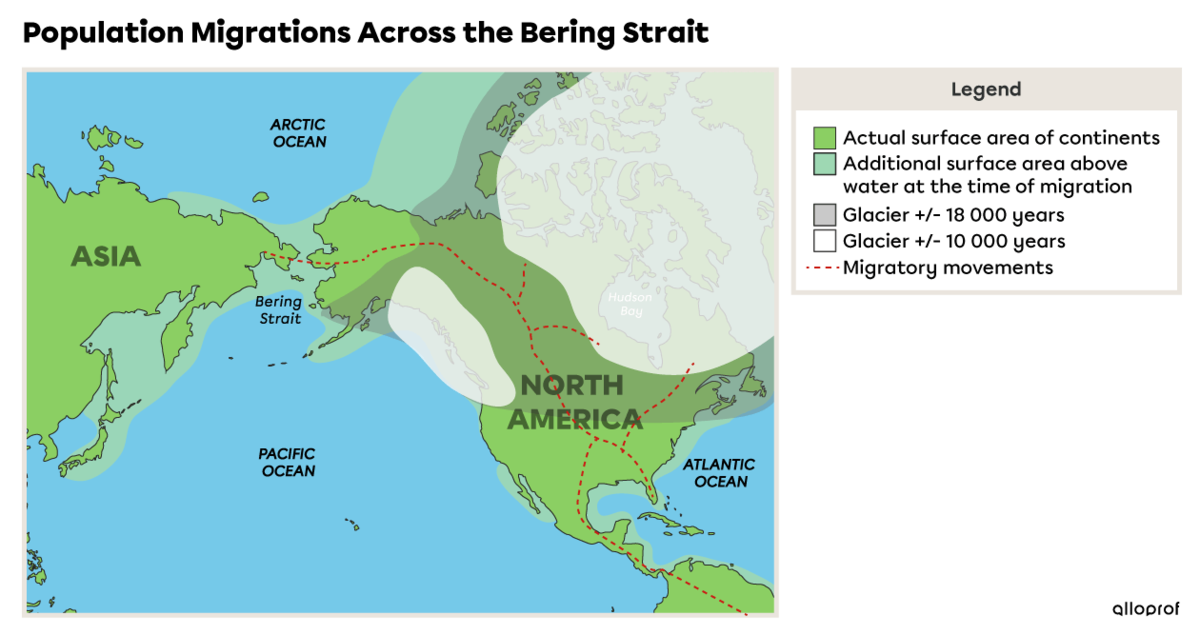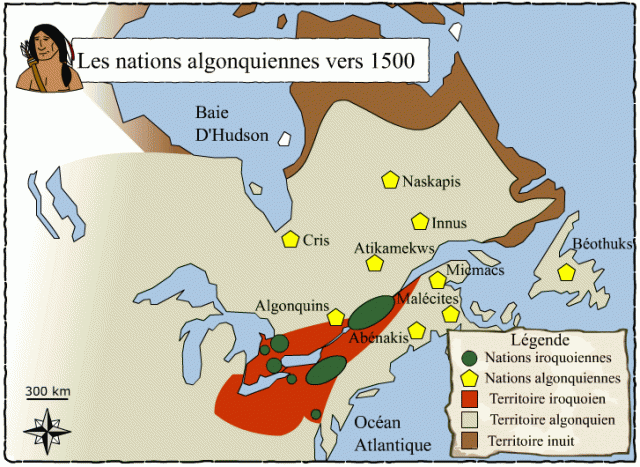Earth’s temperature has varied considerably over the millennia. During the colder periods when temperatures dropped, the ice caps in the North and South poles grew. When such a large amount of water freezes, ocean levels drop by several metres, causing submerged lands to surface.
This is how a vast bridge of land surfaced between Siberia and Alaska, around 18 000 BC, at the height of the last ice age. It was called Beringia.

Map of Beringia’s Estimated Landmass During the Last Ice Age
The most popular theory on the origin of northeastern America’s population is that the fertile lands on Beringia attracted large numbers of woolly mammoths and buffalo, which tribes of Asian hunters followed across. As a result, over a span of about 8000 years, these tribes spread across the continent.
Once scattered around northeastern North America, the groups evolved in very different ways to adapt to their new environment. Over the course of a few millennia, different ways of life and cultures developed, creating great diversity among Indigenous peoples.
This rich diversity was divided into three groups distinguished by the languages they spoke and the ways of life the first occupants adopted in this territory. They were the Iroquoian family, the Algonquian family and the Inuit family. Here is a realistic snapshot of these three language families around 1500, when Indigenous peoples first interacted with Europeans before they had settled on the land.

The Spread of the Three Language Families Were Spread Across Northeastern America, Circa 1500
Iroquoian nations settled in the eastern region of the Great Lakes and in the St. Lawrence Valley. These large waterways with fertile banks were ideal for farming and allowed the different nations to travel efficiently. They also meant that villages could be established in strategic locations to defend themselves against potential enemies. These groups adopted a more sedentary way of life growing corn, squash, beans, sunflowers and tobacco. Once the soil was depleted and could no longer support agriculture, the village was moved to a new location.
About 40 different nations make up the Algonquian family and share a similar way of life. All these groups live in the Appalachian region, the Canadian Shield, in both Quebec and Ontario, and in the northeastern United States. Their land was expansive but stopped at the St. Lawrence Valley where the Iroquoians lived. Even so, the many waterways and vast forests they had access to procured enough materials, fish, small and large game.

Répartition des nations algonquiennes sur le territoire du nord-est de l'Amérique, vers 1500
The Inuit family includes only one nation: the Inuit. The Inuit lived in the northern regions of Canada, the north of Alaska and Greenland. They were the last to cross the Bering Strait between 4000 BC and 1000 BC. The Inuit live north of the 60th parallel, near the Arctic Circle, in an extreme climate that defined northern reality. The winters were long, cold and snowy. There was enough wildlife and plants to survive, but much less when compared to the lands where the other language families lived. Transportation was easy thanks to the various waterways in northern Quebec.
| Iroquoian Family | Algonquian Family | Inuit Family |
|
Iroquoian People of Hochelaga Huron Neutral Petun People of Stadacona |
Algonquian Abenaki Atikamekw Beothuk Cree Innu Malecite Mi’kmaq Naskapi |
Inuit |